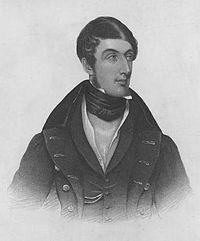Regency Personalities Series-Charles Poulett Thomson 1st Baron Sydenham
Regency Personalities Series
In my attempts to provide us with the details of the Regency, today I continue with one of the many period notables.
Charles Poulett Thomson 1st Baron Sydenham
13 September 1799 – 19 September 1841

Charles Poulett Thomson
Thomson was Born at Waverley Abbey, near Farnham, Surrey, Thomson was the son of John Buncombe Poulett Thomson, a London merchant, by his wife Charlotte, daughter of John Jacob. His father was the head of J. Thomson, T. Bonar and Company, a successful trading firm that had dealings with Russia. After attending private schools until age 16, Thomson entered the family firm at Saint Petersburg. In 1817 he came home due to poor health and embarked on a prolonged tour of southern Europe. He returned to Russia in 1821 and over the next three years travelled extensively in eastern Europe. He established permanent residence in London in 1824 but frequently visited the Continent, especially Paris.
Thomson was returned to the House of Commons as MP for Dover in 1826. In 1830 he joined Earl Grey’s government as Vice-President of the Board of Trade and Treasurer of the Navy, an office he held until 1834. He was then President of the Board of Trade under Lord Melbourne in 1834 and again between 1835 and 1839. A free-trader and an expert in financial matters he was elected MP for Manchester in 1832, a seat which he held until 1839. He was continuously occupied with negotiations affecting international commerce until 1839, when he accepted the Governorship of Canada.
Sydenham succeeded Lord Durham as Governor of Canada in 1839. He was responsible for implementing the Union Act in 1840, uniting Upper Canada and Lower Canada as the Province of Canada and moving the seat of government to Kingston. Later that year, he was raised to the peerage as Baron Sydenham, of Sydenham in the County of Kent and of Toronto in Canada. Upper Canadians were given a choice in the matter of union, which they accepted; Lower Canada had no say, and as a result many French Canadians were opposed to both the union and Sydenham himself. Sydenham was just as anti-French as Durham had been, and he encouraged British immigration to make the French Canadian population less significant. French Canadians referred to him as le poulet, “the chicken”. Realizing he had almost no support in Lower Canada (at this time Canada East), he reorganized ridings to give the Anglo-Canadian population more votes, and in areas where that was infeasible, he allowed English mobs to beat up French candidates. Louis-Hippolyte Lafontaine was one such candidate who suffered from Sydenham’s influence; Lafontaine eventually left Canada East to work with Robert Baldwin in creating a fairer union for both sides.
Sydenham also settled the Protestant land dispute in Upper Canada (at this time Canada West), which the Family Compact had interpreted to refer only to the Anglican Church. Sydenham declared that half of the land set aside for Protestant churches would be shared between Anglicans and Presbyterians, and the other half would be shared between the other Protestant denominations. Sydenham wanted to make Canada more financially independent, so that there would less danger of annexation by the United States.
He had been working on this policy throughout the 1830s, when he was President of the Board of Trade in Britain, though he had little time to implement any economic reforms once he had arrived in Canada. After less than two years as Governor-General, Sydenham died in 1841. He had been described as sickly and an autopsy revealed severe gout. Shortly before his death, he had resigned his position and was due to return to England within weeks. However, on September 4, Sydenham was “riding a spirited horse near Parliament House, but could not, for a long time, get the animal to pass that building. After a severe application of spur and whip, however, the horse proceeded, but immediately after, put his foot upon a large stone… not being able to recover, fell and dragged his rider with him, fracturing the leg, and lacerating it above the knee.” This apparently led to a deadly infection. For fifteen days, Sydenham was described as suffering extreme pain, then died the morning of September 19, 1841. As he was unmarried, his peerage became extinct.





